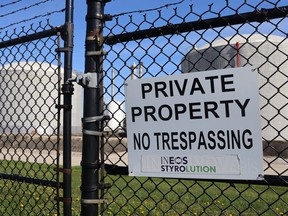Aamjiwnaang First Nation has declared a local state of emergency for the community near Sarnia due to “ongoing and excessive” discharges of benzene from a nearby chemical plant.

Aamjiwnaang First Nation has declared a local state of emergency for the community near Sarnia due to “ongoing and excessive” discharges of benzene from a nearby chemical plant.
Advertisement 2
Article content
“While (Thursday’s declaration) is a serious measure, Aamjiwnaang is doing so. . . to assist in our preparedness and ensure we have adequate resources at our disposal in the event that further action is required,” Chief Chris Plain and the band council said in a statement.
Article content
The First Nation also warned residents to stay away from the band office, playground and ballpark. “There are high benzene readings for this area,” he said.
With the declaration, the First Nation is “seeking help from governments and agencies (to) assess what’s happening to our people,” band councilor Darren Henry said Friday.
INEOS Styrolution, a plant on Tashmoo Avenue next to the First Nation that produces styrene used to make plastics and rubber, is in the process of temporarily shutting down its facility after Aamjiwnaang officials first raised the alarm about high benzene levels April 16. The First Nation said residents were experiencing headaches, nausea and dizziness. A monitoring station in the area showed a high benzene reading at 8 am
Advertisement 3
Article content
The First Nation closed its Tashmoo Avenue offices and staff have been working from home since.

INEOS Styrolution said last Saturday it was temporarily idling the plant “to perform maintenance and address a mechanical issue,” and warned of elevated flaring this week.
The company issued a notice on the Sarnia-Lambton Alerts system Thursday “notifying the community that temporary spikes of greater than 12.5 (parts per billion) may occur as we progress through the current stages of unit shutdown.”
“Due to this impact, we will be putting a hold on all onsite activities for the time being,” the company’s notice said.
The notice did not say what chemical was causing the spikes.
A natural component of petroleum, benzene is primarily used to make polystyrene. It is a known carcinogen and exposure to it may cause leukemia.
Advertisement 4
Article content
About 15 to 20 Aamjiwnaang First Nation families have chosen to leave their homes temporarily, Henry estimated. “We’ve made arrangements for that to happen (for) at least a day or two.”
Recommended from Editorial
“You just need to turn to the CASA (Clean Air Sarnia and Area) website to see all of the over-the-limit benzene emissions that have been going on for the last few days, probably for the last few years,” he said .
“I’ve been in contact with Chief Plain saying, ‘is there anything the city can do to help you during your state of emergency,” Sarnia Mayor Mike Bradley said Friday.
Deputy Fire Chief Dale Gartshore, the city’s emergency management co-ordinator, has been in regular contact with his Aamjiwnaang counterpar, Bradley said.
Advertisement 5
Article content
Bradley said he and senior city officials were expecting to take part in a virtual meeting Friday with INEOS Styrolutions representatives.
“I was quite direct with them,” Bradley said. “It’s a week later, and now you want to communicate.”
Bradley previously expressed his disappointment with lack of communication from the company following high benzene readings last week at the plant, which is in the city.
“This has done severe damage to . . . the Aamjiwnaang community. . . and this community on a health basis, and on trying to eliminate the stereotypes of the past,” Bradley said.
“It’s just disappointing,” he said.
Measures should have been in place while the company was shutting down the facility this week to ensure “our community down Tashmoo Avenue is fully safe,” Henry said.
Advertisement 6
Article content
It appears the company doesn’t “see an urgency to it,” he said. “Yet every day, our people are facing those way out of line benzene levels. It doesn’t appear it’s going to stop too soon, despite our efforts.”
INEOS Styrolution and the office of Ontario Environment Minister Andrea Khanjin did not immediately respond to Postmedia requests for comment.
TIMELINE
January: Provincial Sarnia Area Environmental Health Project report said there was an increased risk of leukemia from benzene levels in the air in some areas of Sarnia and Aamjiwnaang First Nation and recommended Ontario improve regulatory enforcement and review studies on acute benzene exposures to come up with new one- hour and 24-hour air quality guidelines to guide monitoring of benzene and efforts to reduce its release.
Advertisement 7
Article content
Tuesday, April 16: Aamjiwnaang community members report headaches, nausea and dizziness as an air quality monitor station near the band’s Tashmoo Avenue records high benzene levels. Band council calls for shutdown of nearby INEOS Styrolution chemical plant.
Thursday, April 18: Ontario’s Environment Ministry orders the company to develop a plan to “prevent, reduce and eliminate the discharge of benzene from wastewater at the facility,” by April 26, put procedures in place to notify the public when benzene concentrations in the air ”exceed defined thresholds ” and investigate other sources of benzene emission and act to “prevent, decrease and eliminate the discharge.”
Saturday, April 20: INEOS Styrolution said it was temporarily shutting down its Sarnia plant to “perform maintenance and address a mechanical issue.”
Wednesday, April 24: Environment Minister Andrea Khanjin‘s office said the ministry continued to “investigate elevated readings of benzene emissions from the INEOS site and ensure compliance with all orders issued.” The ministry also said it was worked with Aamjiwnaang to install additional air monitoring stations in the community.
Thursday, April 25: Aamjiwnaang First Nation declares local state of emergency due to benzene emissions.
Article content


